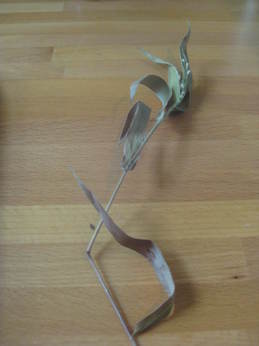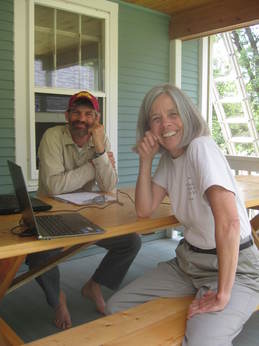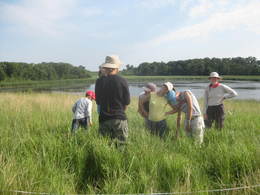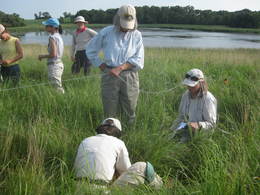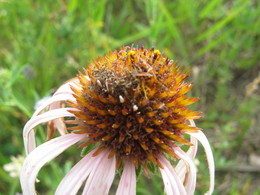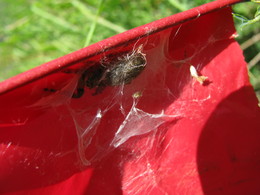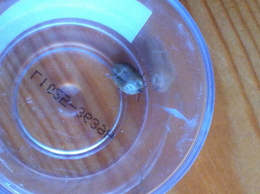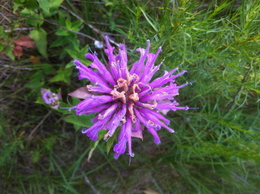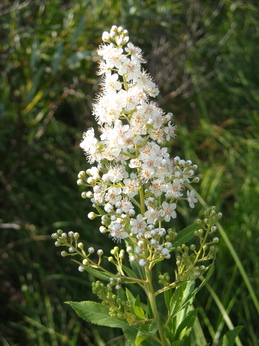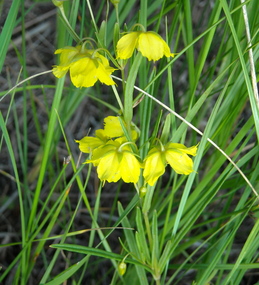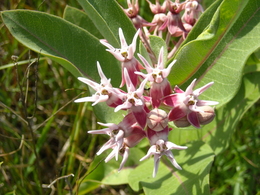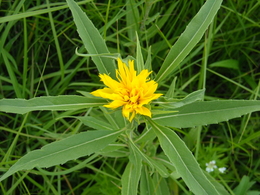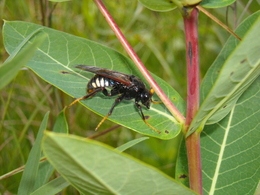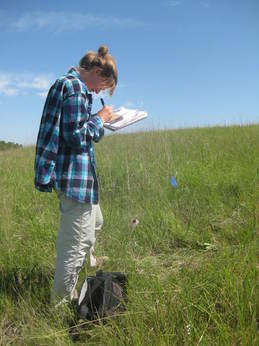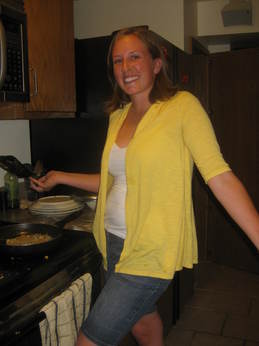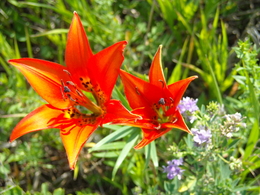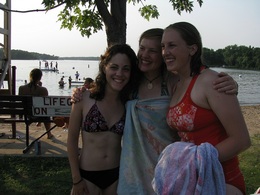|
|
Friday the 13th of July! Sorry for the late posting.
Weather report:
According to my field notes, at 6.35am at Hegg Lake it was warm, no breeze, and a little dewy. The rest of the day, it was hot and humid, though not as bad as the past few days.
Fieldwork report (morning):
I was at Hegg Lake from 6.35am-10.30am, checking on my Dichanthelium plants for seeds that are ready to be harvested. The unfortunate news: 1 of my experimental culms dried out, and another culm was broken off 🙁 On the brighter side, the potted Dichanthelium from my pilot bulk experiment are doing quite well, and a second one started producing spikelets!
Kelly and Shona were out at Staffanson GPSing all the flowering Echinacea plants, including Kelly’s phenology plants.
Andrew and Lydia were in C1 observing and catching pollinators for Andrew’s project. Lydia caught one pollinator. There wasn’t much activity in the garden.
Jill was identifiying ants under the dissecting scope in the basement all morning. She found that many of them were Lasius and Formica.
Katherine was working with the data from the aphid survey and conducting preliminary analyses. She is planning on performing aster analysis with her data.
Ruth, Amy and Brad came over today. After lunch, we headed out to Hegg Lake to Amy’s plots where we measured seedlings that were sowed in 2008. We were out there until almost 6pm, impressive work!

Stuart and Ruth 🙂

Poor broken culm of Dichanthelium. See how some spikelets were still open?

Tired Team Echinacea…

Today most of us started out doing phenology in the Common Garden. Phenology is starting to go much quicker. Hooray! The rest of the morning was spent working on individual projects. Most projects are drawing to a close already. Time sure flies! Jill spent the morning identifying the species she collected from her pitfall traps in the remnants. Maria was found over at Hegg Lake collecting seeds and anthers. She also looked at some dicanthelium at other sites and discovered that they were all mostly done flowering. Kelly and I spent the morning out at our remnants doing phenology and finishing up my experiment. I assessed my last cross for the summer! Some of my crosses were flops due to the caterpillars that ate my anthers and styles. Meanies. How to tell they are there? They leave a TON of frass everywhere.

In the afternoon, we continued to measure plants in the Common Garden. Maybe we’re halfway there? We’ve nonetheless become pros at measuring echinacea. Bring it on!!
After last week’s sultry weather, we’ve been enjoying a “dry heat”, as Greg Diersen so artfully put it. This morning everyone went their separate ways to pursue their individual projects:
Shona, Maria, and Lydia went directly to Hegg Lake and combined forces to measure plants and take GPS points. Shona also photographed Echinacea pallida and E. angustifolia plants as part of her project to assess species traits.
Andrew searched the main experimental plot (C1) for plants where he can observe pollinators. Because peak flowering has passed, his selection of flowering heads is growing slimmer by the day. Fortunately, he has some good observations under his belt and will be able to collect more before plants stop flowering.
Jill and Greg joined forces in operation pit-fall trap. Greg’s traps are bowls full of soapy water that he sets on the ground and leaves out for a couple of days. Jill’s are tubes full of propylene glycol that she submerges in the soil and leaves out for a week. Today, they set out Greg’s traps and collected from Jill’s. I have to say: the smell of dead insects stewing in propylene glycol for a week is probably one of the worst smells I have experienced.
I spent the morning removing aphids from plants in my aphid addition/exclusion experiment. Even though it has been three days since my last exclusion, there were aphids on 11 out of 50 plants in my exclusion group. One plant had 67 aphids–all in three days! Those aphids are moving and breeding fast.
This afternoon we joined together in our common goal of measuring every plant in C1. My mother used to say that the only way to eat an elephant is one bite at a time. Well, today we bit a big chunk off of our elephant, finishing up the sections planted in 1997, 1998, and 1999. We have less than half an elephant to go!
And now for a picture. In addition to helping us keep track of plants, pin flags make great habitat for spiders:

Today was a pretty standard mid-summer day for Team Echinacea. Because of the early flowering, there is no lack of work to be done in order to keep up with the flowers. In the morning, Jill and Katherine emptied Jill’s pitfall traps at the Northwest Landfill, North-Northwest Landfill, and East Elk Lake Road sites. They found lots of insects including thatch ants and several different types of ground beetles. Lydia and I went out to several of the remnants to work on our phenology and incompatibility research. Andrew and Shona worked together on Andrew’s pollinator observations in the C1 Garden. After a string of unlucky days it looks like the bees are finally coming out again! Maria continues to wake up before the sun to observe Dicanthelium , although it sounds like they have stopped producing pollen so a well-earned reprieve might be on the way.
In the afternoon we measured away in C1. We’ve finally made it to the ’99 garden! I think we might be half way done!
Here’s a picture of our new mascot. He was generously brought to us by Roxy last Thursday and we’re all very excited to have such a unique pet!

In case you can’t tell from the picture, that’s a pretty swelled up tick. Ew!
To end on a slightly prettier note, here’s a picture of Monarda fistulosa, also known as Bee Balm. This plant was flowering at Pembina Trail Preserve yesterday, but I saw others flowering today at Staffanson Prairie Preserve. To me they look like something straight out of a Dr. Seuss book!

This morning most of us got a taste of Maria’s regular schedule when we arrived at the Hjelm house by 6am for a special trip. We drove three hours Northwest to the Pembina Trail Preserve to help Gretel count western prairie fringed orchids for her work with the Nature Conservancy.
Unfortunately it seems to be a bad year for orchids and we only managed to find one that wasn’t even in either of the grids we were searching (In previous years there have been as many as 2,000 in the combined grids). As we were searching we met another group that was surveying the entire preserve, and they reported that they had only found 23 flowering orchids, so I guess we were lucky to see any at all!
here is the one flowering orchid we did see:

Gretel isn’t sure exactly what has caused this sad state, but a few of her hypotheses are the late frost, a potential disease, or drier conditions than in previous years.
Although we were disappointed by the lack of orchids, we did see many new plant species and wildlife that we haven’t seen around K-town. Here are a few of them:
Spiraea alba

prairie loosestrife- Lysimachia quadriflora

Showy milkweed-Asclepias speciosa

Helianthus maximiliani

along with an insect that I have yet to identify:

I wasn’t able to get photos of any of the birds, but we saw northern harriers, red tailed hawks, meadow larks, king birds, bobolinks, a whole flock of sandhill cranes, an upland sandpiper, an american bittern (Stuart claims that they are also called prairie pump handles for the sound they make), and a dick cissel perched on a shrub near the path singing to whoever was listening.
On the way home, after ridding ourselves of as many ticks as possible, Gretel treated us all to delicious locally made ice cream, and dinner at a Mexican restaurant, in that order.
While we were all gone Katherine and Maria stayed behind to work on their projects.
Maria collected dichanthelium seeds and kept track of phenology at Hegg Lake, and Katherine cleaned and entered data.
Today was a quiet Sunday in K-town. While I indulgently slept in this morning, here’s what was going on in the field:
-Katherine, Shona, and Kelly surveyed flowering Echinacea in the common garden
-Andrew successfully observed 5 pollinators of Echinacea today, a much more productive session than some of his sessions earlier in the week
-Lydia crossed some Echinacea and painted floret bracts at Around Landfill and East Elk Lake Road, two of the prairie remnants
-Kelly visited all of her prairie remnants today, observing and recording the various stages of flowering Echinacea in each
-Maria worked with her Dicanthelium at Hegg Lake
Other than fieldwork, a few of us went out to Alexandria yesterday to explore the downtown, visit Big Ole, and nab some Cherry Berry, our favorite self-serve frozen yogurt bar. We also discovered that if you buy a t-shirt and wear it to Cherry Berry on Tuesdays, you can get free frozen yogurt! Yum!

Tomorrow, the gang is heading out to Pembina Trail Preserve (between Fertile and Crookston, MN) to count Western prairie fringed orchids (Platanthera praeclara) in wet prairie. Photos to come!
(Again, I can’t figure out why my photos always flip sideways when I upload them or how to fix it)
Despite the wet and windy weather, the morning proceed as usual with each of us working dutifully on each of our respective projects. Jill and Katherine were especially productive, flagging and surveying all of their plants in Staffanson, a task which took all morning until 2. Shona completed her last hybrid cross and Lydia, Maria, and Kelly continued their field work. Unfortunately, I was not quite as successful since the pollinators do not seem to like eating during storms. The clouds retreated in the afternoon and we were able to get a substantial amount of measuring done; It’s a large garden, but we are making great progress. The exciting event of the day was a discovery: Josh’s Nalgene which he lost in the west side of Staffanson last summer. It survived a year of weathering and a spring burn just fine and still had water in it and a functioning lid. 
Nope we did not sleep in until 9pm. On the contrary, we spent our Saturday morning doing fieldwork! Team Echinacea is really dedicated to our independent projects!
Saturday was a clear day with cool temps in the morning but temperatures rose around mid morning.
Kelly was doing phenology and Lydia was painting bracts and bagging heads for her crosses at the remnants.
Jill and Katherine finished up their aphid remnant survey, and Katherine stayed on at C1 to do her aphid addition/exclusion. It was a full day for Katherine (9 hours and 20 min lunch break).
Andrew went to C1 to watch pollinators, but unfortunately not many were up and about.
Shona was at Hegg Lake observing the last taking photos of Echinacea

Yours truly was also at Hegg Lake from dawn till 11.30am, doing Dichanthelium pollen addition (only 4 spikelets needed pollen addition, looks like the Dichanthelium are finishing up flowering!)
One of the great things about doing fieldwork in the early morning is the chance to witness spectacular views of the outdoors. I stopped several times on the way to my site to get pictures of this magnificence:

5:32am on Kittleson Road.
In the afternoon, some of us chilled out at home, took naps, went for a run, did groups abs exercise. Kelly, Lydia, Jill and Shona went to downtown Alexandria for some sightseeing and groceries. After they got back (around 8pm), we started making pancakes (gluten free corn pancakes, Katherine’s recipe) and Kelly’s authentic Spanish dish Tortilla Espanola. The pancakes turned out to be scrambled as we did not know the secret (=patience!). Thanks to the help of Jill and Shona, we managed to commence dinner at 9pm. After dinner, we all helped clean up. Then everyone (except myself because I had to get myself to bed) played bananagrams.

yay Kelly!
After three very hot days, the humidity dropped slightly today, to the point where we weren’t all sweating just standing outside, and there was even a nice breeze off and on.
As usual most of us spent the morning working on individual projects.
Kelly and Lydia helped Katherine and Jill with their projects and collected lots of ants.
Gretel and Andrew have teamed up to add a new piece to Andrew’s pollinator efficiency project where they will paint the bracts of pollinated styles, germinate seeds, and determine their genetic heritage to gain a better idea of how much pollen bees spread and from where (maybe one of them will explain more about that later).
Maria and I were out at Hegg Lake again, but it looks like I’ll be done with my crosses by the end of the week! So soon I’ll be able to start the next part of my project and help more with the main group work.
In the afternoon the whole crew went out into the common garden to work on measuring and we worked quickly enough that we even managed to finish a little bit early.
It’s only my fourth week here but I already feel like the colors of the prairie and the flowers I see are changing.
Here is a photo of one of my favorites that I’m beginning to see less frequently.
Lilium philidelphicum:

We were all having so much fun on the 4th of July that I forgot to write the events of the day.
Technically, the 4th of July is a day off for the Echinacea crew. Plants don’t celebrate national holidays, so we spent the morning assessing flowering phenology in the main experimental plot. After that, Andrew experienced a series of unfortunate events that kept him from observing pollinators. On the upside, he learned some valuable lessons and made a new friend.
Because aphids don’t take holidays either, I spent the latter part of the morning visiting plants in my aphid addition/exclusion experiment to remove aphids from the exclusion group. The goal of my experiment is to capture the effects of aphids in natural conditions–i.e. no cages or bags. That means that in order keep aphids off of the plants in the exclusion group, I need to visit them every few days to remove them by hand. For fifty plants (plus fifty more in the addition group) that’s a lot of footwork.
We celebrated America’s national holiday with a picnic at Elk Lake. We crammed in as many all-American activities as we could: potlucking, canoeing, sand-castle building, frying in the sun. If things weren’t American enough, Stuart brought a print-out of the Declaration of Independence, which we all took turns reading around the picnic blanket. Go America!
I didn’t get a good group picture, but here’s a cute shot of Jill, Shona, and Kelly:

|
|
